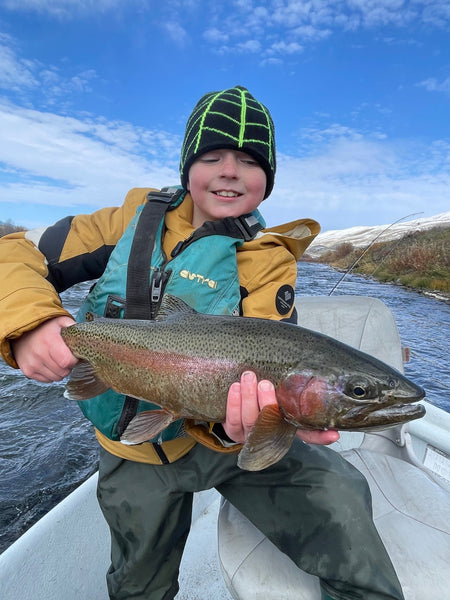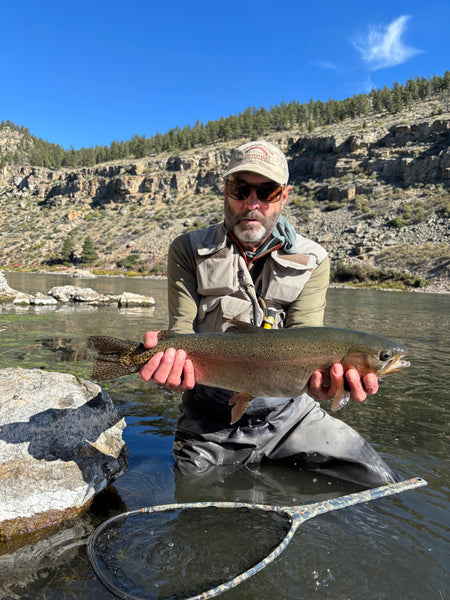Floating the Upper Madison Before Run-Off
Floating the Upper Madison Before Run-Off
By Jake Schilling
January 6, 2020
Although West Yellowstone will be under several feet of snow until late April, it is certainly time to get excited (and ready!) for spring floating on the Upper Madison. While full-on run-off will put a damper on float fishing, the wade fishing can be outstanding, as many of you know. But for today's blog, we're going to focus on floating the Upper Madison in the Pre and Early stages of run-off where flows are slightly high, but mostly still clear or light green. This time period is generally March, but weather, of course, will dictate when run-off occurs.
During this time of year, we're generally floating closer to Ennis as the upper float stretch (Lyon-McAtee) still has most of its fish tight to the bank with the colder water temps. Depending on how much you want to stop and hop-out to fish, you can keep your floats pretty short. Hopping out and wade fishing tends to be the most productive approach as fish will 'stack-up' in the slower, deeper runs. Compared to spreading out everywhere come late June when the hatches start in earnest.
Where to look for fish
When I first started guiding, the best advice I received for reading water on the Madison River was, "Look for anywhere where the water is a gear (or two) slower than the rest of the river." If you can find areas like this that also have at least 2 feet of depth, you'll run into fish. If you're not finding them there, look for spots even slower. Let’s go over a few examples-
Islands. Another reason to float closer to Ennis is the numerous islands and larger side channels. Now, this is true for most of the year, but fish Love hanging out on the downstream side of islands in the spring. Islands are a great break in the current and the water on the downstream side will generally drop to 3' deep. Perfect holding water!
Side Channels. Channels are almost always slower than the main river. In these channels, you can expect to find more structure with downed logs than rocks/boulders. But just like a classic pocket at $3 bridge, they will hold in these current breaks. Another fun spot in channels is the low end where they meet the main river. Those seams tend to be very productive.
Green Buckets. AKA Green Buckets of Death. Simply said, it looks like someone came in with an excavator and took a scoop out of the river bottom. They are generally an off-green color from the moss. These are great spots out in the middle of the river to cast into while on the move. If you're nymphing, make sure to start your drift upstream enough so they have time to sink into the bucket before it ends. Remember the water is cold and the fish generally don't move up for flies as they will in the summer.
Flies
Let's start with nymphs. I know this is blasphemy in some circles, but I really don't care for rubberlegs. Yes, they mimic stoneflies well enough, are heavy, and get eaten. But in the day and age of czech/euro flies that get down quicker, there are so many better options that the good ol ' rubberleg!
Nymphs
Here are a few of my favorite-
- #12 Fulling Mill Red Tag Jig
- #14 Fulling Mill Olive Biot
- #14 Olive Grub
- #10 Golden Biot Stonefly
- #14 Red Neck
- #18 Lightning Bug
- #18 Guide Dip
- #18 Crystal Dip
- #12 Woolly Worm
Yes, there were no eggs in that list. Fish eat nymphs, well.
Dries
Early season dry fly fishing is a blast. Unlike summer where you can chase different hatches all day, in the spring the timing is fast and may be it for the day. Besides midges, baetis, and March Browns, have a few Skwalas around! A dry-dropper with a Skwala and smaller stone nymph is a very fun way to fish while on the move between wade spots.
Streamers
There are a wide variety of steamers that produce this time of year. You can find some very aggressive fish that have moved up from Ennis Lake. From my experience, I've had great luck over the years with larger patterns replicating crayfish and sculpins. As I mostly two-hand cast now while fishing streamers, I've fished less and less articulated patterns and have gone towards mid-sized buggers and leeches.
Fly Rods
When floating early spring, I keep a wide range of rods with me to keep my client's options open as conditions change quickly. Below is an outline of what I'm bringing along each day, some of the below are out of production now but were replaced with similar counterparts.
-
9'6" 4 wt. Sage One. If I had to pick one versatile rod, this is it! The extra length and fast action (for a 4 wt.) let this rod do it all; single-hand spey, czech nymphing, indicator nymphing, dry flies, and smaller streamers.
-
Winston Super-10, 3 wt. Best euro/czech rod I've fished to date. Awesome light action but plenty of backbone when an Ennis lake rainbow goes squealing across the river.
-
9' 5 wt. Winston GVX. Another versatile rod with a medium action. I'm weird and always like the GVX over the BIIX.
- 7'9" Sage Circa. On those rare days of zero wind, this is my rod of choice for small dries.
-
11' 3wt Echo TR. Awesome rod for trout-spey, awesome action and casts plenty far for the swing water we have on the Madison River. Pair this with an OPST Commando.
- 9'6" 7 wt. Sage Method. Yup, it’s stiff. But it'll throw a full sink line and weighted eyes no problem in that Madison valley wind. Yeah, be ready for wind.
Drift Boat
If you haven't already, it's time for a little boat keep-up. Time for new ropes, extra plugs, straps, and all our required gear by the state; extra oar, life jackets, first aid kit, etc. And double-check under your seats for that lucky PB&J that's been getting furry since Halloween.

Conditions change quickly, don't hesitate to call (406-646-9644) or email (trout@madisonriveroutfitters.com) for the most up to date conditions! We'll roll out another blog soon with all the links for local USGS gages. Time to start reading these daily with your morning coffee.
This is the first article in a 4 part series on Spring Fly Fishing by Jake Schilling.
Wade Fishing the Upper Madison River During Run-Off
Spring Fly Fishing on Hebgen Lake
Must-Have Fly Fishing Information for West Yellowstone

About Jake Schilling - Professional Fly Fishing Guide at Madison River Outfitters
When 21 years old, Jake moved to West Yellowstone from Missoula (where he grew up) in May 2012. That first summer he spent two months living in a tent, before buying a 1971 Lark camper. After three years of working in the shop and part-time guiding, Jake moved into a full-time guide job with MRO. Living in West Yellowstone year-round since 2015 now, his knowledge of the area is vast. Besides guiding, during the summer Jake stays busy fishing gulpers & Spey casting. During the winter he spends his time Czech nymphing, steelhead fishing, and cross-country skiing while off work from the Yellowstone Club. Jake’s laid-back attitude and patience is unmatched, he loves taking the day slow; walking the boat and always having one more fly to try before moving on.
Leave a comment
Comments will be approved before showing up.
Also in Madison River Fishing Report - Upper Madison River Fishing Report - Greater Yellowstone Area Fishing Reports

Madison River Outfitters Fishing Report for 10/21/2025
This is the Last Report of the Year! Have a Great Winter, and We'll See You All This Spring!!








Jake Schilling
Author